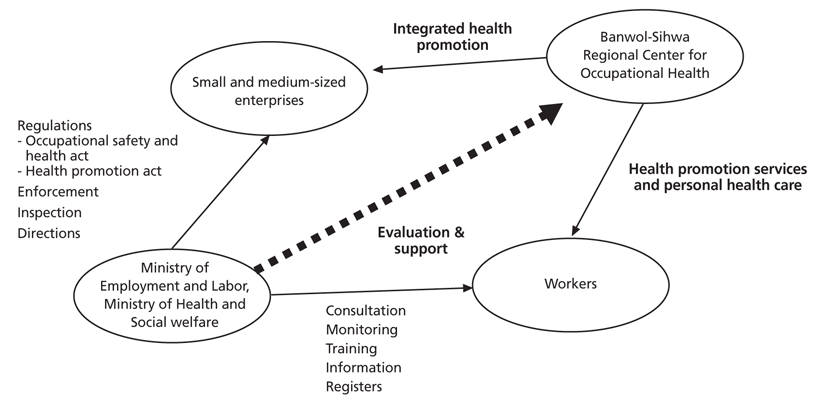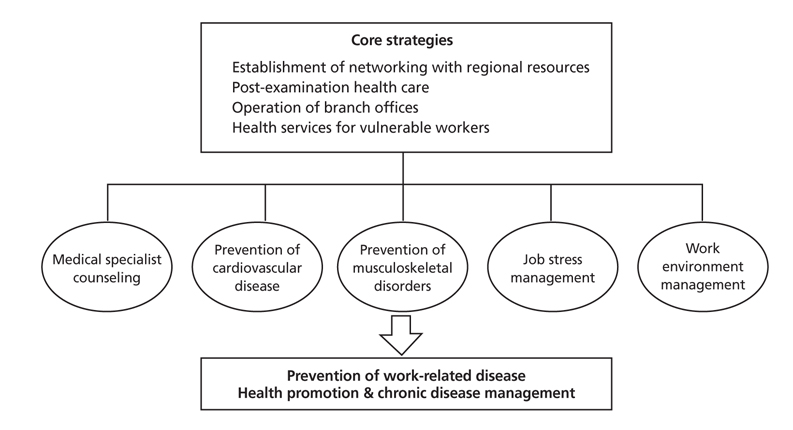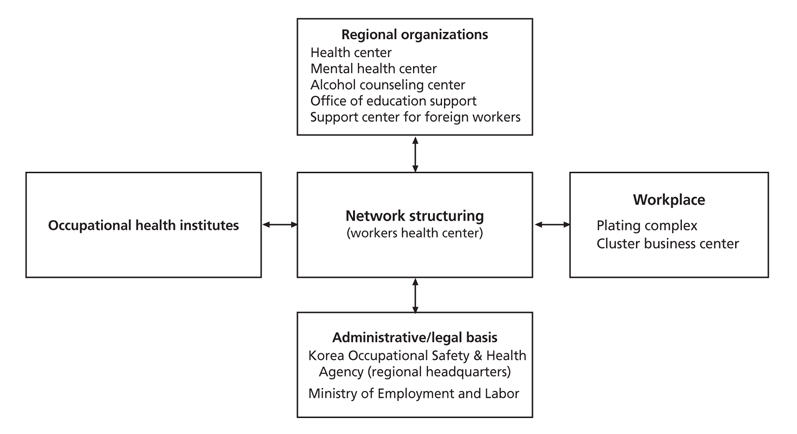J Korean Med Assoc.
2014 Feb;57(2):159-166.
Significance and prospect of workers health center
- Affiliations
-
- 1Department of Occupational and Environmental Medicine, Korea University Ansan Hospital, Ansan, Korea. impjt@korea.ac.kr
- 2Gyeonggi-seobu Workers Health Center, Siheung, Korea.
- 3Korea Occupational Safety and Health Agency, Incheon, Korea.
Abstract
- Systematic health management is crucial in small-sized enterprises since the number of enterprises and their employees make up a large proportion of all businesses and they account for the majority of industrial accidents and occupational illnesses. The Korean government had operated the Banwol-Sihwa Regional Center for Occupational Health to provide occupational health services and chronic disease management to the workers in small-sized enterprises as a pilot health promotion project from 2007 to 2010. Since then, Gyeonggi-seobu workers health center (WHC) was established in 2011 to provide physician care for small-sized enterprises through the Industrial Accident Compensation Fund. The WHC has provided basic occupational health services including health promotion activities to prevent work-related diseases. Core strategies of the WHC were networking with regional health resources, post-examination care for workers with abnormal findings in health screenings, the operation of branch offices for better accessibility, and services for vulnerable workers including immigrant, women, and elderly workers. An evaluation of WHCs conducted in 2012 showed excellent performance in terms of cost-effectiveness, high satisfaction, and intent toward continuous use among visitors. For the advancement of WHCs, visiting services to the worksites have to be integrated adequately with services in WHCs, and more subsidiary centers need to be established for better accessibility. Moreover, the expansion of the service items and development of specialized health programs are needed. Measures should be considered to systematically collect health data and identify workplace risk factors to improve the quality of post-examination care.
MeSH Terms
Figure
Reference
-
1. Ministry of Employment and Labor. Status of industrial accidents in 2011s. Gwacheon: Ministry of Employment and Labor;2012.2. Park JT. Study on the effectiveness of industrial disaster reducing policy in small size workplaces. Incheon: Korea Occupational Safety and Health Agency;2006.3. Hino Y, Kan H, Minami M, Takada M, Shimokubo N, Nagata T, Kurita M, Uchida K, Mori K. The challenges of occupational health service centers in Japan. Ind Health. 2006; 44:140–143.
Article4. Brosseau LM, Li SY. Small business owners' health and safety intentions: a cross-sectional survey. Environ Health. 2005; 4:23.
Article5. Cho YH, Lee MS, Kim MS, Kim HL. A phenomenological study on the subsidiary program of health management in small scale industries. J Korea Community Health Nurs Acad Soc. 1998; 23:1–12.6. Domnin SG, Zhovtiak EP, Gol'del'man AG. 25-year experience of Sverdlovsk regional occupational center on the basis of the research institute. Med Tr Prom Ekol. 2000; (3):30–33.7. Zen'kov LN. Experience of Grodno regional occupational health center. Med Tr Prom Ekol. 2002; (4):25–28.8. Piktushanskaia IN. Activities of the regional occupational health center under present-day conditions. Med Tr Prom Ekol. 2002; (11):25–30.9. Fasikov RM, Khuzhakhmetova IB, Stepanov EG. Occupational and non-occupational factors influencing health state of small and medium business workers. Med Tr Prom Ekol. 2010; (6):16–20.10. Januskevicius V, Telksniene R. Occupational health care system and its effectiveness in Lithuania. Int J Occup Med Environ Health. 2002; 15:155–158.11. Elsler D. Economic incentives to improve occupational safety and health: a review from the European perspective. Luxembourg: Office of the European Union;2010.12. Hirata M, Kumagai S, Tabuchi T, Tainaka H, Andoh K, Oda H. Actual conditions of occupational health activities in small-scale enterprises in Japan: system for occupational health, health management and demands by small-scale enterprises. Sangyo Eiseigaku Zasshi. 1999; 41:190–201.
Article13. Terada H, Sone T. A study on effective implementation of the Shinjuku Regional Occupational Health Center Program in Japan. Sangyo Eiseigaku Zasshi. 2000; 42:49–60.
Article14. National Health Service. NHS occupational health services for NHS staff and the broader community [Internet]. [place unknown]: National Health Service;2011. cited 2014 Dec 27. Available from: http://www.uhbristol.nhs.uk/for-clinicians/avon-partnership-nhs-occupational-health-services.15. Black CM. Working for a healthier tomorrow: Dame Carol Black's review of the health of Britain's working age population. Norwich: The Stationery Office;2008.16. Great Britain Department for Work and Pensions. Improving health and work: changing lives. the government's response to Dame Carol Black's review of the health of Britain's working-age population. Norwich: The Stationery Office;2008.17. Rasanen K, Husman K, Peurala M, Kankaanpaa E. The performance follow-up of Finnish occupational health services. Int J Qual Health Care. 1997; 9:289–295.
Article18. Presidential Committee on Ageing and Future Society. Comprehensive report of the public sector in health care. Gwacheon: Ministry of Health and Welfare;2004.19. Lee SW, Kim DS, Kang SK. Industrial health: regional occupational health promotion center in Korea for the purpose of promoting health of small scale industry workers-assessment of the first year's results. Seoul: Korean Industrial Health Association;2008.20. Ju YS. Regional occupational health center evaluation of pilot projects. Incheon: Korea Occupational Safety and Health Agency;2008.21. Park JT. Sustainability of the business community to improve the diagnosis and accessibility. Incheon: Korea Occupational Safety and Health Agency;2010.22. Lee H. Community networks to enable the principles and suggestions for. Gunpo: Grass-root Autonomy Institute;2008.23. Industrial Safety and Health Act. Article 43, Law No. 11882. 2013. 06. 12.24. Ju YS. General health examination survey follow-up and improvement plan, including research. Gwacheon: Ministry of Employment and Labor;2011.25. Ministry of Employment and Labor. Health examination workers based on health examination carried out. Gwacheon: Ministry of Employment and Labor;2002.26. Lee KY. Analytical research on the vulnerable workers. Incheon: Korea Occupational Safety and Health Agency;2006.27. Choi JW, Kim JA, Kim HJ, Park JT. A study of working status and industrial accidents for migrant workers in Korea. Korean J Occup Environ Med. 1999; 11:66–79.
Article28. Yoon JD, Kim YM, Lee HG, Kwon YJ, Kim JS, Choi GC, Lee HM, Lee JE, An JS. Non-regular workers' status and a special form of insurance coverage applied for working professionals expand. Seoul: Korea Labor Institute;2004.29. Korea Occupational Safety and Health Agency. Care helper of industrial accidents and preventive measures. Incheon: Korea Occupational Safety and Health Agency;2011.30. Choi GH. Workers health center monitoring and the development direction of the operation. Incheon: Korea Occupational Safety and Health Agency;2012.31. Baldwin ML, Butler RJ. Upper extremity disorders in the workplace: costs and outcomes beyond the first return to work. J Occup Rehabil. 2006; 16:303–323.
Article32. Sin YS. Tasks for future health and welfare policy. Seoul: Ministry of Health and Welfare;2012.
- Full Text Links
- Actions
-
Cited
- CITED
-
- Close
- Share
- Similar articles
-
- Toxicological Evaluations of Rare Earths and Their Health Impacts to Workers: A Literature Review
- A Comparative Study on Health Status and Health Determinants of Foreign Workers and Native Workers
- Development and Prospect of Occupational Safety and Health Education
- Understanding the Occurrence of Lung Cancer in Foundry Workers through Health Insurance Data
- A Study on Attitude and, Practice of Village Health Workers Supervised by Health Subcenter in Rural Area, Su-dong Myun




